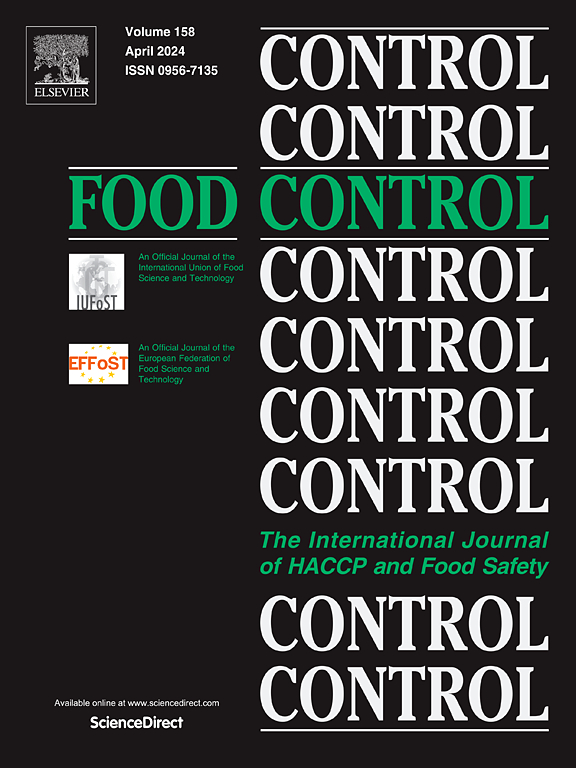采后薄荷醇对鲜切生菜褐变抑制和品质保持的影响
IF 6.3
1区 农林科学
Q1 FOOD SCIENCE & TECHNOLOGY
引用次数: 0
摘要
酶促褐变限制了鲜切生菜的保质期和商业价值。本研究探讨了薄荷醇对生菜茎部褐变的抑制作用及其机制。薄荷醇处理减少了鲜切生菜在4℃下的褐变,提高了生菜的感官品质。转录组学分析显示,薄荷醇调节了与酚代谢和氧化应激反应相关的基因表达网络。同时,对多酚氧化酶(PPO)、过氧化物酶(POD)和苯丙氨酸解氨酶(PAL)活性的抑制作用分别高达84.63%、17.70%和85.40%,导致酚类化合物积累和醌生成减少。此外,薄荷醇通过上调超氧化物歧化酶(SOD)和过氧化氢酶(CAT)活性(分别为30.62%和22.51%)降低活性氧(ROS)含量,同时降低脂氧合酶(LOX)活性(60.34%)并减轻脂质过氧化作用。结合相关分析,结果表明薄荷醇处理通过协调调节酚代谢和氧化应激反应,缓解了鲜切茎莴苣的酶促褐变,表明薄荷醇处理有望成为一种抗褐变剂。本文章由计算机程序翻译,如有差异,请以英文原文为准。
Postharvest menthol application for browning inhibition and quality maintenance in fresh-cut stem lettuce
Enzymatic browning limits the shelf life and commercial value of fresh-cut stem lettuce. This research examined the browning inhibitory effect of menthol on stem lettuce and its underlying mechanism. Menthol treatment reduced browning and improved the sensory quality of fresh-cut stem lettuce at 4 °C. Transcriptomic analysis revealed that menthol modulated gene expression networks associated with phenolic metabolism and oxidative stress responses. Concurrently, it suppressed the activities of polyphenol oxidase (PPO), peroxidase (POD), and phenylalanine ammonia-lyase (PAL) by up to 84.63 %, 17.70 %, and 85.40 %, respectively, leading to decreased phenolic compound accumulation and quinone formation. Additionally, menthol reduced reactive oxygen species (ROS) content by upregulating superoxide dismutase (SOD) and catalase (CAT) activities (30.62 % and 22.51 %, respectively), while simultaneously lowering lipoxygenase (LOX) activity (60.34 %) and alleviating lipid peroxidation. Combined with correlation analysis, the findings revealed that menthol treatment alleviated enzymatic browning of fresh-cut stem lettuce through coordinated modulation of phenolic metabolism and oxidative stress responses, suggesting its promise as an anti-browning agent for fresh-cut produce.
求助全文
通过发布文献求助,成功后即可免费获取论文全文。
去求助
来源期刊

Food Control
工程技术-食品科技
CiteScore
12.20
自引率
6.70%
发文量
758
审稿时长
33 days
期刊介绍:
Food Control is an international journal that provides essential information for those involved in food safety and process control.
Food Control covers the below areas that relate to food process control or to food safety of human foods:
• Microbial food safety and antimicrobial systems
• Mycotoxins
• Hazard analysis, HACCP and food safety objectives
• Risk assessment, including microbial and chemical hazards
• Quality assurance
• Good manufacturing practices
• Food process systems design and control
• Food Packaging technology and materials in contact with foods
• Rapid methods of analysis and detection, including sensor technology
• Codes of practice, legislation and international harmonization
• Consumer issues
• Education, training and research needs.
The scope of Food Control is comprehensive and includes original research papers, authoritative reviews, short communications, comment articles that report on new developments in food control, and position papers.
 求助内容:
求助内容: 应助结果提醒方式:
应助结果提醒方式:


